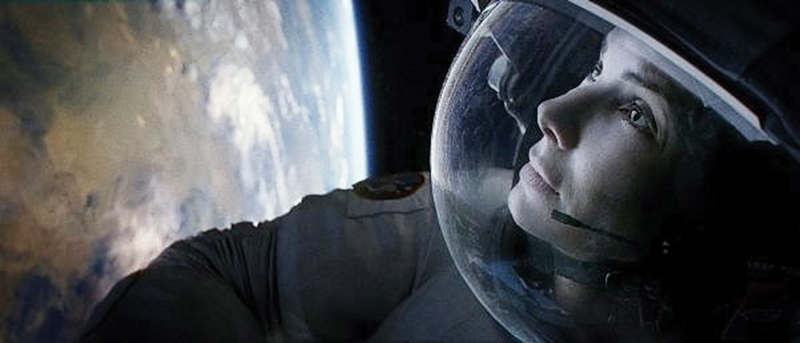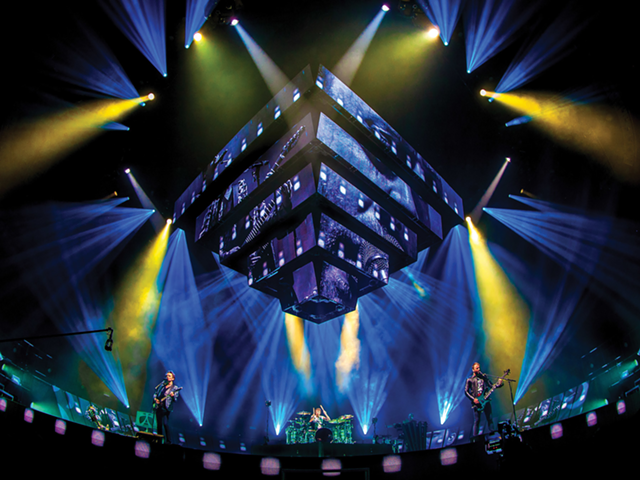Most critics will rush to compare Gravity, the new science fiction thriller from director Alfonso Cuarón (co-written by the director’s son Jonás) to films ranging from Stanley Kubrick’s classic 2001: A Space Odyssey to possibly Steven Soderbergh’s remake of Andrei Tarkovsky’s Solaris or maybe even recent 3D extravaganzas like James Cameron’s Avatar or Martin Scorsese’s Hugo (a lush and fully realized use of effects from a director not necessarily known for such a striking visual effects palette).
But one of the more obvious comparisons stands right before us, in Cuarón’s previous efforts.
Like most of the directors on the list (with the possible exception of Cameron), Cuarón’s focus has been on the narrative side of things. Strong characters locked in intimate relationships populating diverse worlds have dominated his works; stories rendered with swift, deft strokes. There has always been a sense of rhythm in Cuarón’s films, but seemingly never concerted attention for minutely detailed sensory immersion.
And yet, in one startling sequence from his 2006 adaptation of the P.D. James novel Children of Men, Cuarón proved to have not only the eye, but also a truly daring sensibility. It involves a car chase — actually, a car under attack from an unruly mob and a gun-toting pair on a motorcycle. The pace is fevered and frenetic, although completely different from what we’ve come to expect from action franchises like The Transporter or The Fast and the Furious. Cuarón cares little for blurring images whizzing by or jump-cutting back and forth between racing vehicles. No, this is all about the tight space, the interior of a packed car, the fear and passion inside one vehicle under siege.
The sequence demands repeat viewings because there’s a trick, an actual visual sleight of hand at play in how the scene was shot. During the entire scene, we never venture outside the cabin of the car. The fact that Cuarón even attempted such a feat would be worthy of respect, but what is truly amazing is how effortlessly the scene plays out. Brilliant technical execution speaks to the notion of all the effort to not let the effort show.
In Gravity, Cuarón goes from one sequence to an entire film’s worth of perfect execution, while exponentially increasing the degree of difficulty along the way. He wants us to feel the weightlessness of space, the adrenalized fear of being cut off, adrift from that sense of grounding that we take for granted. And it should all feel both claustrophobic and infinitely boundless at the same time. What happens when a voice provides the only lifeline, the last thread that keeps us from floating away into the blackest of black nights?
My initial viewing experience was second to none: in a private upscale hotel screening room during the Toronto International Film Festival. My field of vision was encased in a visor-like pair of 3D glasses, so completely contained that I went nearly half an hour before I even realized there was anyone else in the room with me and, when I lowered my gaze for the first time, nearly jumped out of my seat when the back of someone’s head popped into view.
Fortunately, I re-adjusted and was back into Cuarón’s world. I offer that curious aside to point out that Gravity needs to be seen in 3D, under the best circumstances available to you. Pay for the premium IMAX presentation, because what Cuarón presents to the eye only heightens the impact on your other senses.
It is fascinating to note that I’ve gone this far into discussing the movie without much mention of the performances. I’ve felt since that festival screening that Gravity is such a technical marvel it obscures the work of its stars — Sandra Bullock and George Clooney — but, truth be told, there’s only one performance that matters.
Bullock is the lead, the main presence. She is us and we are her. Bullock is a medical researcher (a specialist rushed through astronaut training for this specific mission), a fish-out-of-water Everywoman and newbie who will be tested beyond any reasonable reckoning. She will face a level of fear and adversity that we could never imagine without watching her situation unfold before us. And Bullock delivers, despite being overshadowed by the immensity of the moment.
In fact, her work here rises to the challenge because it creates a sense of grounding, an anchoring that Cuarón has taken from us. He comes close to stranding us without anything to hold onto, but Bullock pulls us in and keeps us centered during what could have been a most disorienting ride. (Opens wide Friday) (PG-13)
Grade: A
CONTACT
TT STERN-ENZI: [email protected]






